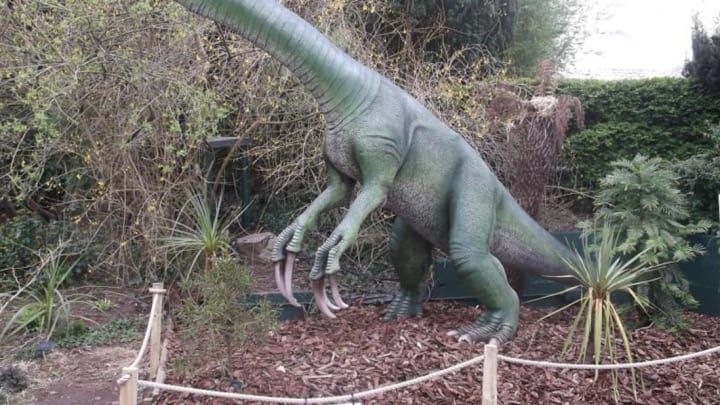If T. rex is the Citizen Kane of dinosaurs, Therizinosaurus and its kin are The Rocky Horror Picture Show: They’re strange-looking, slightly threatening, and command a dedicated fan base. Here’s some trivia guaranteed to impress your fossil-loving amigos.
1. Therizinosaurus Had the Longest Claws of Any Known Animal
The humongous claws on this dino’s hands were capable of reaching well over two feet in length. Appropriately, its name literally means “scythe lizard.”
2. Despite This, it Was (Probably) An Herbivore
With fingers that seemingly belong in a slasher flick, you’d think these creatures were designed to slice and dice hapless victims. But most of its relatives had small, leaf-shaped teeth built to munch on foliage. (Scientists have yet to uncover a Therizinosaurus skull.) So what’s with those frightening digits? The theory is that, come mealtime, they might have helped the dinos pull down lush tree branches. For a cooler explanation, skip ahead to bullet point number nine.
3. Therizinosaurus Was Originally Mistaken for a Huge, Turtle-Like Reptile.
In 1954, Russian paleontologist Evgeny Aleksandrovich Malayev concluded that the beast basically resembled a modern sea turtle. He wrote that its distinctive forelimbs were in fact “powerful swimming organs” with claws designed for “cutting aquatic vegetation.”
4. It’s Part of a Formerly-Baffling Family.
When it became clear that these things were actually dinosaurs, scientists didn’t initially know how to classify the eccentric Therizinosaurids. Could they be related to the gigantic, long-necked sauropods like Jurassic Park’s Brachiosaurus? Or did they belong to the "bird-hipped" order of dinosaurs along with Stegosaurus and Triceratops?
Despite their plant-guzzling habits, closer examination revealed that therizinosaurs hailed from a group known as theropods, the vast majority of which (Tyrannosaurus, Velociraptor, etc.) were carnivores. Strange as this might sound, today’s pandas (which only occasionally eat meat) are similarly considered members of the mammalian "carnivora" order.
5. Some Therizinosaurs Were Covered in Feathers.
China’s Beipiaosaurus had multiple layers of primitive feathers, as seen in some beautifully-preserved fossils. Given its limb proportions, Beipiaosaurus definitely didn’t fly, so this plumage likely served to keep it warm and attract the opposite sex.
6. A Nest of Therizinosaur Eggs Was Found in 2013.
After locating 17 clutches of dinosaur eggs in the Gobi Desert, Hokkaido University’s Yoshitsugu Kobayashi concluded that they’d been laid by indigenous therizinosaurs, a few bony remains of which had been unearthed nearby. If true, this would imply that the animals were somewhat social (at least, come nesting season).
7. Therizinosaurs Had Weird Feet.
Ever the nonconformists, therizinosaur feet rested on four toes while standing and walking. Most theropods, meanwhile, only used three.
8. Therizinosaurus Was One Hefty Dino.
Let’s return to Therizinosaurus itself, shall we? The red areas in the above picture represent all of its presently-known skeletal material (the rest has yet to be found). Based on these partial remains, scientists have ascertained that the critter’s total length was somewhere in the ballpark of 10 meters (33 feet) while it could’ve weighed upwards of 5 tons. Not too shabby…
9. Therizinosaurus Had to Cope With a Huge T. rex Cousin.
Tarbosaurus bataar and Tyrannosaurus rex are so similar that they may have belonged to the same genus (though most experts disregard that idea). The former predator occupied Therizinosaurus’ Mongolian range roughly 70 million years ago, making this herbivore’s fearsome claws look all the more necessary. Here’s a cool (Greek language) clip from 2002’s Chased by Dinosaurs documentary in which these natural enemies spectacularly square off.
10. There’s a Life-Sized Therizinosaurus Statue in Poland.
Jurapark, located in the village of Bałtów, contains dozens of full-scale dinosaur models, including Allosaurus, Diplodocus, and the world-famous Iguanodon.
